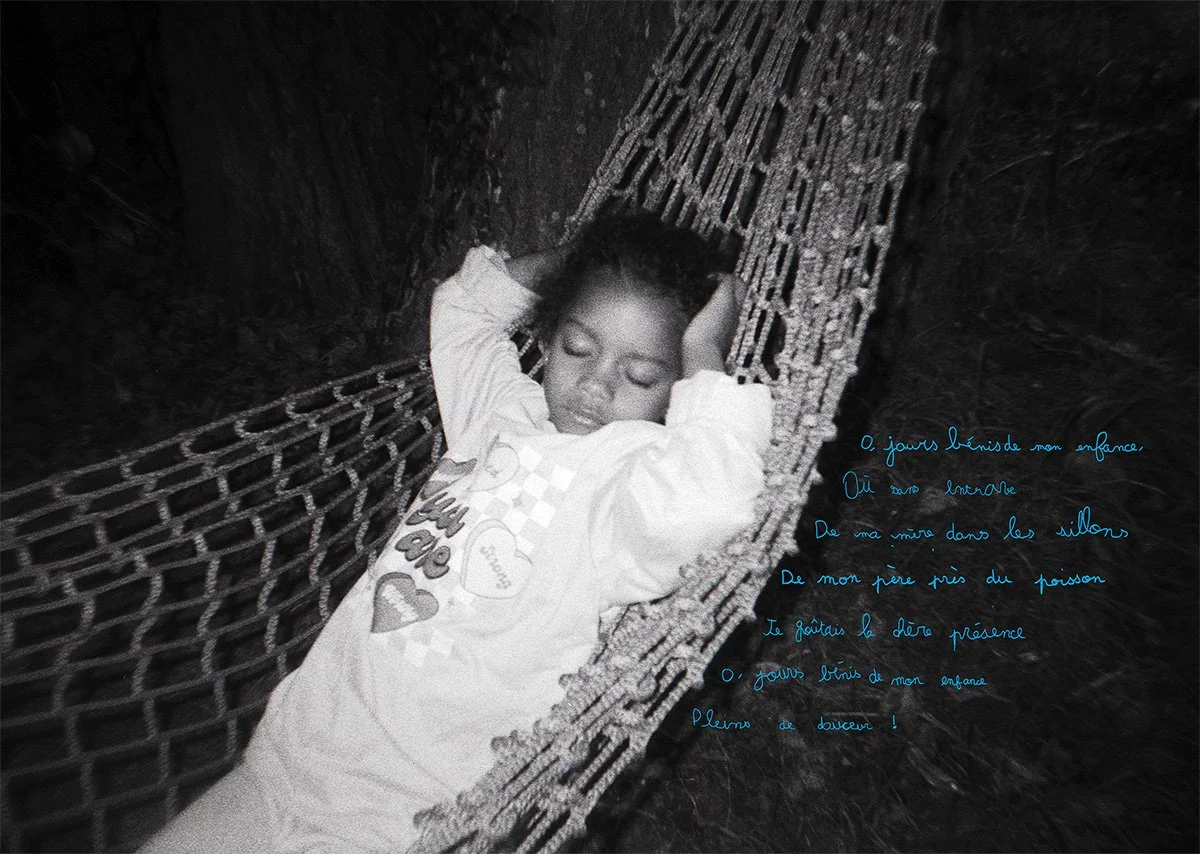En pleine mer ou je suis né
Le Lieu de la Photographie, Lorient
Clément Chapillon a fait une résidence de transmission insulaire avec 19 enfants de l'école primaire de l'école La Trinité et l'EPHAD Ty Laouen dans le cadre d'un programme pédagogique "entre les images". Ainsi il a pu accompagner les enfants à la découverte de leur île, ils ont reçu chacun deux pellicules. Quarante-huit images, en couleur et en noir et blanc qu’ils ont réalisées à ses côtés, mais aussi dans l’intimité de leur chambre et de leur famille. Et au fil de ce dialogue, c’est l’île qui se révèle par fragments. L’île habitée, aimée, photographiée de l’intérieur n’est pas un décor, mais une présence vivante. La créativité s’est exprimée de la prise de vue à la création des journaux et de l’exposition qui s’est déroulée sur l’île grâce à une scénographie collective. Ce projet a été réalisé grâce au soutien des partenaires indispensables au projet : Le Lieu de la photographie, Fondalor, le réseau Diagonal et le bistro Bao de Groix.
Pour des jambes d'enfant, le rivage c'est toujours un peu loin. Et puis chaque étape est un jeu, une occasion de se cacher, une branche qui devient une épée, un rocher à escalader. Les enfants regardent le monde avec le microscope de leurs désirs. La limite ce n'est pas non plus l'horizon. Tout change si vite, les nuages, les couleurs du soir et celles du matin, la pluie aussi comme une grande herse grise qui vient sans se soucier des hommes. Il n’y a que la porte de l’école ou la lampe et les odeurs de la maison pour se détourner du plein ciel et de ses questions.
Une île pour les enfants, ce sont aussi tous ces visages que l'on connait, des rencontres sans crainte, des noms précis, parfois des sobriquets, qui disent chaque personne et les récits qui permettent à chacun d’avoir une place.
Quelques mots qui rassemblent des conversations ni jamais tout à fait entendues ni entièrement ignorées. On sait simplement qu’elles disaient des liens familiaux, pourquoi un champ se nomme comme ceci ou comme cela, et pourquoi on peut faire confiance.Une île c'est un univers bien à sa place. Un lieu sûr d'où l'on peut regarder venir les vents avec leur bagages de feuilles et mesurer, de génération en génération, l'obstination de l'eau à user le rocher.Les enfants d'une île éprouvent très tôt ce mélange d'évidences et d'énigmes et le « travail photographique » a consisté à leur permettre d'interroger cet ordinaire qu’à trop le voir on oublie de regarder. De l’éprouver autrement puisque qu'une photo n'est après tout qu'un monde que l’on émiette au gré de ses goûts et de sa mémoire.
Yannick Jaffré, anthropologue
“L’enfance est bien sûr une étape de la vie, mais c’est aussi une manière d’être au monde : non pas tournée vers l’avenir, mais vers l’intensité du présent.”
“Leurs photographies ne cherchent rien.
Elles montrent.”
“Un lien s’est tissé entre les enfants et moi, entre l’archive et l’instant, un point d’appui sur la mer, pour raconter autrement l’histoire de Groix.”
“La plupart des élèves ont aujourd’hui un rapport faussé à la photographie, souvent réduite à l’usage du téléphone portable. J’ai beaucoup aimé observer leur enthousiasme à accueillir Clément et ses appareils photo en classe. Très vite, ils ont accepté de ne pas voir immédiatement le résultat de leur travail et ont compris le caractère précieux de l’appareil qu’ils avaient entre les mains. Ils étaient si fiers de pouvoir les emmener chez eux.”
“Le rapport au temps a été largement exploré au cours de ces ateliers. La photographie permet de l’arrêter un instant et de conserver une trace de son passage. Le travail sur les archives photographiques, ainsi que les rencontres et discussions avec les anciens de l’île, ont permis aux élèves d’établir des liens entre le passé et le présent, notions encore floues à leurs âges.
”
“Les résidents de l’EHPAD Ty Laouen, Jo Le Port, n’ont pas seulement transmis des souvenirs : ils ont offert des fragments de l’île que seuls les cœurs anciens savent lire. Ils ont parlé avec des mots polis par le sel, contant des histoires qui ont résisté à l’oubli.”
“À travers la photographie, ce projet mené par Clément Chapillon et porté par Le Lieu de la Photographie a tenté d’esquisser ce que Romain Rolland appelait le sentiment océanique. Reste de cette traversée un fil tissé entre les générations, des images imprégnées de bleu, de granit et de mémoire, et peut-être, au creux de chacune, le murmure d’un mystère que seule une île peut encore offrir.”
Et peut-être qu’à la fin, ne reste-t-il qu’un peu de cet or du temps que cherchait Breton. Un éclat fragile. Une lumière première. Celle des enfants, celle d’une île, celle où ils sont nés.






































